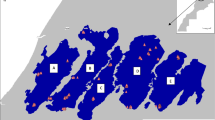Abstract
Genetic variation in the cork oak (Quercus suber L.) was investigated using 11 loci from seven enzyme systems in 40 populations sampled over the entire distribution of this species in the western Mediterranean Basin. Mean heterozygosity values over the polymorphic loci (Ho=0.283), the percentage of polymorphic populations (M=0.76), and the total genetic diversity (Ht=0.31) from which 11% was accounted for among-population variation, are among the highest recorded in oak species. In contrast to previous results in holm oak (Q. ilex L.), another evergreen species in the same area, cork oak possessed a smaller allele pool and a lower average number of alleles per locus and per population (A=2.0). More particularly, very few low-frequency alleles were observed in cork oak except for eight populations in which allozyme polymorphism at locus Pgi 1, diagnostic between both species, indicates that these low-frequency alleles are introgressed from holm oak. On the basis of the genetic distance estimated from allozyme frequencies, 32 of the 40 cork oak populations studied were classified into two very distinct sets which also corresponded to distinct geographic areas. One set gathered together the 18 populations from the Iberian peninsula and two adjacent areas in France, i.e. the centre of origin of cork oak, according to paleobotanical data. This set was characterized by a larger allele pool, a higher within-population genetic diversity and a lower differentiation between populations than was observed in the other set, which comprised the populations from North Africa, Sicily, Sardinia, Corsica, continental Italy and the region of Provence (southeastern France). In these more southern and eastern disjunct areas, cork oak migration from Iberia may have occurred at different periods since the end of the Tertiary. The possible effect of human activity on cork oak genetic structure, i.e. the selection of good-quality cork, acorn over-use for animal food, and even human nutrition, is discussed.
Similar content being viewed by others
Author information
Authors and Affiliations
Additional information
Received: 3 March 1998 / Accepted: 19 March 1998
Rights and permissions
About this article
Cite this article
Toumi, L., Lumaret, R. Allozyme variation in cork oak (Quercus suber L.): the role of phylogeography and genetic introgression by other Mediterranean oak species and human activities. Theor Appl Genet 97, 647–656 (1998). https://doi.org/10.1007/s001220050941
Issue Date:
DOI: https://doi.org/10.1007/s001220050941




